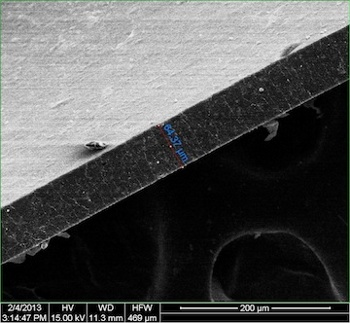
Graphene Gas Barrier Composite
October 30, 2013 Many experiments are conducted under vacuum, and scientists have been aided by the many advances in vacuum technology since 1643, when the Italian physicist, Evangelista Torricelli, first produced a laboratory vacuum by inverting a closed container filled with mercury. The historical unit of pressure, the torr, symbolizing a millimeter's height of mercury, is named after him. The torr is presently defined as 1/760 of a standard atmosphere. | Evangelista Torricelli (1608-1647) When Torricelli inverted a mercury column in 1643 to form the first technical vacuum, he incidentally created the first barometer. The asteroid, 7437 Torricelli, is named in honor of Torricelli's achievements. (Via Wikimedia Commons.) |
 | An electron micrograph of graphene nanoribbons embedded in a block copolymer. (Rice University image by Changsheng Xiang.)[4] |
"The idea is to increase the toughness of the tank and make it impermeable to gas... This becomes increasingly important as automakers think about powering cars with natural gas. Metal tanks that can handle natural gas under pressure are often much heavier than the automakers would like."[4]This research was funded by the Air Force Research Laboratory and the Office of Naval Research.[4]
References:
- Standard ASTM E493/E493M - 11, "Standard Practice for Leaks Using the Mass Spectrometer Leak Detector in the Inside-Out Testing Mode," ASTM International.
- Rick Lingle, "Barrier materials for rigid packaging nears $95 billion for 2012," Packaging Digest, February 11, 2013.
- Changsheng Xiang, Paris J Cox, Akos Kukovecz, Bostjan Genorio, Daniel P Hashim, Zheng Yan, Zhiwei Peng, Chih-Chau Hwang, Gedeng Ruan, Errol L. G. Samuel, Parambath M Sudeep, Zoltan Konya, Robert Vajtai, Pulickel M Ajayan and James M. Tour, "Functionalized Low Defect Graphene Nanoribbons and Polyurethane Composite Film for Improved Gas Barrier and Mechanical Performances," ACS Nano Just Accepted Manuscript (DOI: 10.1021/nn404843n, October 8, 2013).
- Mike Williams, "Tanks, graphene! Rice advances compressed gas storage," Rice University Press Release, October 10, 2013.
- Dmitry V. Kosynkin, Amanda L. Higginbotham, Alexander Sinitskii, Jay R. Lomeda, Ayrat Dimiev, B. Katherine Price and James M. Tour, "Longitudinal unzipping of carbon nanotubes to form graphene nanoribbons," Nature, vol. 458, no. 7240 (April 16, 2009), pp. 872-876.
- Geoff Brumfiel, "Nanotubes cut to ribbons - New techniques open up carbon tubes to create ribbons," Nature News, April 15, 2009.
- Rick Lingle, "Barrier materials for rigid packaging nears $95 billion for 2012," Packaging Digest, February 11, 2013.
